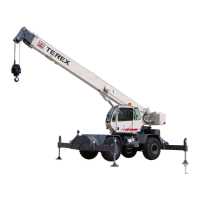Effects of Wind Conditions
Wind Speed Detection
It is essential that you observe the permitted maximum wind speeds. To check the wind
speed, the crane can be equipped with an air speed indicator (anemometer).
This consists of two elements:
1. Rotor - fitted to the head of the main boom or main boom extension.
2. Display - on the screen. The rotational movement of the rotor caused by the wind is
converted into an electrical signal which is displayed on screen in the crane operator’s
cab. The crane operator can read off the wind speed here in m/s.
Before commencing work or erecting the equipment it must be ensured that the
anemometer is fully functional. If the values on the display change when the rotor
is rotated, the unit is functioning.
To verify functionality during conditions of no wind, the rotor should be manually
rotated.
Lifting Constraints
The crane can be used safely by following the values given in the load capacity tables up to
a wind speed of 27.8 ft/s (30 kph - force 5) on a load surface of 13 ft²/tonne.
Check the forecast and monitor wind speed conditions near the job site. When
wind speed exceeds 27.8 ft/s (30 kph - force 5), derating of the cranes lifting
capacity is required. See the cranes WARNING section of the LOAD CHART.
MAXIMUM OPERATIONAL WIND SPEED BEFORE DERATING OF LIFTING CAPACITY IS
REQUIRED.
39P/N 12261-319 REVISED: August 2012
Courtesy of Crane.Market

